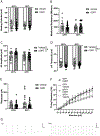Effects of Corticosterone on the Excitability of Glutamatergic and GABAergic Neurons of the Adolescent Mouse Superficial Dorsal Horn
- PMID: 37437798
- PMCID: PMC10530204
- DOI: 10.1016/j.neuroscience.2023.07.009
Effects of Corticosterone on the Excitability of Glutamatergic and GABAergic Neurons of the Adolescent Mouse Superficial Dorsal Horn
Abstract
Stress evokes age-dependent effects on pain sensitivity and commonly occurs during adolescence. However, the mechanisms linking adolescent stress and pain remain poorly understood, in part due to a lack of information regarding how stress hormones modulate the function of nociceptive circuits in the adolescent CNS. Here we investigate the short- and long-term effects of corticosterone (CORT) on the excitability of GABAergic and presumed glutamatergic neurons of the spinal superficial dorsal horn (SDH) in Gad1-GFP mice at postnatal days (P)21-P34. In situ hybridization revealed that glutamatergic SDH neurons expressed significantly higher mRNA levels of both glucocorticoid receptors (GR) and mineralocorticoid receptors (MR) compared to adjacent GABAergic neurons. The incubation of spinal cord slices with CORT (90 min) evoked select long-term changes in spontaneous synaptic transmission across both cell types in a sex-dependent manner, without altering the intrinsic firing of either Gad1-GFP+ or GFP- neurons. Meanwhile, the acute bath application of CORT significantly decreased the frequency and amplitude of miniature excitatory postsynaptic currents (mEPSCs), as well as the frequency of miniature inhibitory postsynaptic currents (mIPSCs), in both cell types leading to a net reduction in the balance of spontaneous excitation vs. inhibition (E:I ratio). This CORT-induced reduction in the E:I ratio was not prevented by selective antagonists of either GR (mifepristone) or MR (eplerenone), although eplerenone blocked the effect on mEPSC amplitude. Collectively, these data suggest that corticosterone modulates synaptic function within the adolescent SDH which could influence the overall excitability and output of the spinal nociceptive network.
Keywords: glucocorticoid; intrinsic firing; mineralocorticoid; spinal cord; stress; synapse.
Copyright © 2023 IBRO. Published by Elsevier Ltd. All rights reserved.
Conflict of interest statement
Declaration of Competing Interest The authors declare that they have no known competing financial interests or personal relationships that could have appeared to influence the work reported in this paper.
Figures





References
-
- Abbott FV, Franklin KB, Connell B (1986) The stress of a novel environment reduces formalin pain: possible role of serotonin. European journal of pharmacology 126:141–144. - PubMed
-
- Baba H, Goldstein PA, Okamoto M, Kohno T, Ataka T, Yoshimura M, Shimoji K (2000a) Norepinephrine facilitates inhibitory transmission in substantia gelatinosa of adult rat spinal cord (part 2): effects on somatodendritic sites of GABAergic neurons. Anesthesiology 92:485–492. - PubMed
-
- Baba H, Shimoji K, Yoshimura M (2000b) Norepinephrine facilitates inhibitory transmission in substantia gelatinosa of adult rat spinal cord (part 1): effects on axon terminals of GABAergic and glycinergic neurons. Anesthesiology 92:473–484. - PubMed
Publication types
MeSH terms
Substances
Grants and funding
LinkOut - more resources
Full Text Sources

